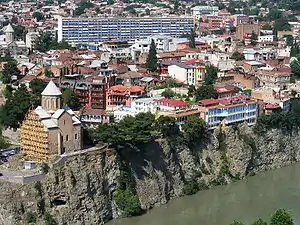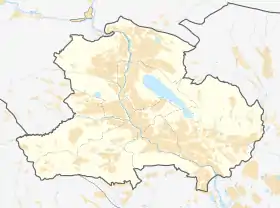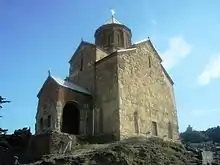Avlabari
Avlabari (Georgian: ავლაბარი Avlabari, Armenian: Հավլաբար Havlabar) is a neighborhood of Old Tbilisi on the left bank (east side) of the Kura River. The 11th-13th century chronicles mention it as Isani, which is now one of the larger municipal regions of Tbilisi. Nowadays one of the upcoming hip neighborhoods of the city, Avlabari is being extensively gentrified.
Avlabari
ავლაბარი | |
|---|---|
Neighborhood of Isani District | |
 | |
 Flag | |
 Avlabari The map of Tiflis in 1914. You can see Avlabari district in right down part of the map. | |
| Coordinates: 41°41′35″N 44°48′57″E | |
| Country | Georgia |
| City | Tbilisi |
| Raioni | Old Tbilisi |
| Time zone | UTC+4 (Georgian Time) |
The Armenian community
Avlabari (Armenian: Հավլաբար Havlabar) was long known as the center of Armenian life of Tbilisi.[1] The Armenian Pantheon of Tbilisi is located in Avlabari. Until recently Avlabari was populated heavily by Armenians, but recently their number have diminished.
Churches
The churches in the Avlabari district include:
- The Holy Trinity Cathedral of Tbilisi - the third-tallest Eastern Orthodox cathedral in the world
- The Metekhi Church - the oldest church in Avlabari
- Church of the Red Gospel, Tbilisi, a ruined 18th century Armenian Apostolic Church
- Ejmiatsin Church, Tbilisi, an 18th-century Armenian church near Avlabari Square
Transportation
The neighborhood is served by the Avlabari metro station.
Notable residents
- Arshak Ter-Gukasov, Russian-Armenian general (1819-1881)
- Nikol Aghbalian, Armenian public figure and historian (1875-1947)
Gallery
 Metekhi Georgian cathedral
Metekhi Georgian cathedral The 18th century Saint Ejmiatsin Armenian Church
The 18th century Saint Ejmiatsin Armenian Church The ruined Armenian Church of the Red Gospel
The ruined Armenian Church of the Red Gospel.jpg.webp) Remnants of Darejan Palace.
Remnants of Darejan Palace.
References
- Arus Harutyunyan, Contesting national identities in an ethnically homogeneous state, Western Michigan University, p.184
This article is issued from Wikipedia. The text is licensed under Creative Commons - Attribution - Sharealike. Additional terms may apply for the media files.